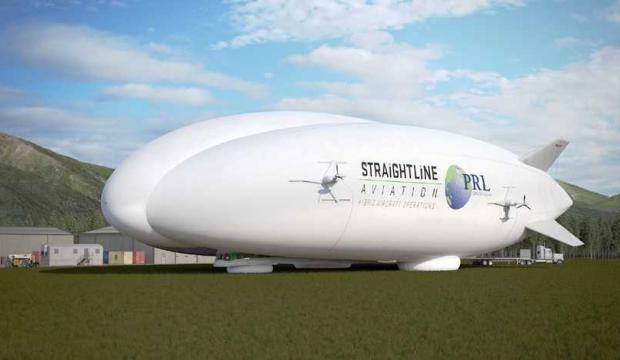Possibilities that a new airship design may bring to Kenai include a $10 million hangar, science educational activities, local jobs and a chance to fly liquefied natural gas to remote Alaska.
Founder and CEO Ron Hyde of transportation and contracting company PRL Logistics gave Kenai City Council members an update on Wednesday about his plans to base a Lockheed Martin hybrid airship at PRL’s compound on the south side of the Kenai River mouth, as well as the possibility of moving PRL’s corporate headquarters to Kenai from Anchorage.
In August 2016, the Anchorage-based PRL first announced plans to put Lockheed Martin’s LMH-1 hybrid airship — so called because it generates lift with both an aerodynamic shape and a helium-filled envelope — to work on projects in Alaska. The LMH-1 could make remote areas of Alaska more accessible to smaller companies. Its vertical takeoff and landing ability lets it deliver 47,000-pound cargos to places without landing strips, and its operating cost is lower than planes that can transport comparable cargoes.
Alongside PRL, other organizations began planning to lease the LMH-1 from its licensed operator, the United Kingdom-based Straightline Aviation, in late 2016. These include the Canadian mining company Quest Rare Minerals and the nonprofit radiology group RAD-AID, which plans to use the craft as a mobile radiology clinic in Africa. The 15 airships now under construction in Palmdale, California, will cost about $44 million, Hyde said, and will be ready for use in 2019.
Since the announcement in August, Hyde and his partners have also been developing Alaska missions for the airship. He said his group is working with ExxonMobil on modular liquified natural gas tanks that could be installed in the airship’s cargo bay and used to deliver North Slope gas to isolated communities. PRL is also patenting a portable camp system that can be deployed from the airship, Hyde said.
For work in remote areas, Hyde said that logistics can account for up to half a project’s cost. His goal for the new vehicle is to cut that cost, making economic opportunities in remote Alaska accessible to smaller independent companies that don’t have billions to spend on building airstrips, ports and temporary roads.
“Alaska can’t depend on megaprojects to carry it through, so you’ve got to count on a number of successful small projects,” he said. “Right now, that’s very expensive. If the cost of being able to do remote construction and responsible resource development can be reduced through reducing the logistics cost, some projects that might be close to going may actually go.”
In late May, Hyde said he’d be meeting with President Donald Trump and the U.S. Department of Transportation to “outline how this ship’s going to be a game-changer.”
“(Trump) has already been briefed, and we’ve provided him with slides and introductions to the technology,” Hyde said.
To house the aircraft in Kenai, PRL plans to build a hangar on the south side of the Kenai River for an estimated $10 million.
“That hangar can also stunt-double — because it can hold 6,000 people in it — potentially as a community center,” Hyde said. “And if that ship is sitting in that hangar for any period of time, then I’ve failed in my mission to have it working on the North Slope and in Western Alaska and other places. So we see some dual benefit there, and we’ll want to work closely with the community to see what kind of design criteria may be useful for that kind of stuff.”
The airship base would hire and train pilots, mechanics and ground crew members. Hyde said he’d try to hire locally.
Along with the airship, Hyde is also considering moving PRL’s accounting, procurement and technical teams from Anchorage to an office in Kenai.
“With the amount of work we’re able to execute down here, it makes sense to have our corporate capabilities located here as well,” Hyde said, adding that Lockheed Martin may also have a small Kenai office in support of the airship.
Other groups could also benefit from the scientific and technical expertise that could accompany the airship to Kenai — Hyde is a board member of Kenai’s Challenger Learning Center, a science education nonprofit, which he said may plan educational activities related to the airship and its makers.
Reach Ben Boettger at ben.boettger@peninsulaclarion.com.

